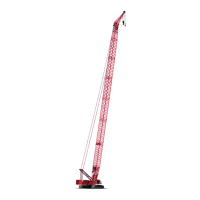Manitowoc Published 05-03-17, Control # 228-03 3-45
16000 SERVICE/MAINTENANCE MANUAL ELECTRIC SYSTEM
is the sum of all identifiers that are ON in that bank. Each
possible ON/OFF combination per bank has a unique total.
To determine the status of an individual digital input or
output, determine the CAN packet number (see Table 3-3
through Table 3-6). For example, the Drum 1 Brake packet
number is CAN26-1-64.
The first part of the Code Number (26 in the example)
indicates which packet contains the CAN communications
for that input or output.
The second part of the Code Number (1 in the example)
indicates the bank where the individual information is shown
on the CAN screen.
The third part of the Code Number (64 in the example) is the
item identifier.
To determine the status of the individual input or output, find
the total in bank 1 (255 in the example). Reference the total
in the numbered column of Table 3-10
. In the corresponding
row, the identifier numbers that are on in the bank are
shaded. In the above example, the column for 64 is shaded,
indicating the Drum 1 Brake is on.
Digital Output Disable (DOD) Fault
See Figure 3-30, Items 4 and 5 for the following procedure.
The control system is capable of detecting an open or short
circuit in most of the system’s digital outputs. When the fault
section of the display screen shows “Fault 84-Digital Output
Disable”, check for DOD faults in packets 36 through 41:
1. Scroll through packet numbers 36 through 41.
2. Check banks 1, 2, and 3 on the CAN bus screen for a
value of 255. If the value is less than 255 in banks 1, 2,
or 3, use the bank identifier numbers in Table 3-10
to
determine which bits are off.
3. Use Table 3-3
to determine which outputs are not
working.
4. Investigate the indicated outputs for a short to ground, a
short to the shield, or another problem.
Engine Node Status
See Figure 3-30, Item 6 for the following procedure.
The engine displays node bus status is for factory use only.
The communication number should be less than 64. See the
engine manufacturer manual for engine fault code
information.
Load Link Status (900 MHz System)
See Figure 3-30, Item 7 for the following procedure.
The load link sensor icons indicate the selected load sensor
operating status. The selected link sensor is operating
normally if the blue antenna icon is displayed. If the sensor is
not operating normally, the following numbers indicate the
type of communication error:
4—Calibration fault
8—Radio frequency (RF) state. The selected link sensor is
not communicating.
64—Sign-on error
128—RF communication error
The following numbers indicate the drum load link and
wireless remote battery status:
32 On, 16 On—75% to 100% battery charge
32 On, 16 Off—50% to 75% battery charge
32 Off, 16 On—25% to 50% battery charge
32 Off, 16 Off—0% to 25% battery charge
Load Link Status (2.4 GHz System)
See Figure 3-30, Item 7 for the following procedure:
The load link sensor icons indicate the selected load sensor
operating status. The selected link sensor is operating
normally if the blue antenna icon is displayed. If the sensor is
not operating normally, the following numbers indicate the
type of communication error:
8—Radio Frequency (RF) state. The selected link sensor is
not communicating.
32—Calibration fault
64—Sign-on error
128—RF communication error
The battery status is shown in bank 4 on the CAN Bus
screen for the corresponding packet number. The drum 1-
packet number is 141. The drum 2-packet number is 142.
The drum 3-packet number is 143. The drum 6-packet
number is 144. The following numbers indicate the battery
status:
15—Full battery charge
0—Critically low battery charge
Remote Control Status
See Figure 3-30, Item 8 for the following procedure:
The remote control status icon identifies which remote
control is active according to the following numbers:
1—Crane remote
2—MAX-ER remote

